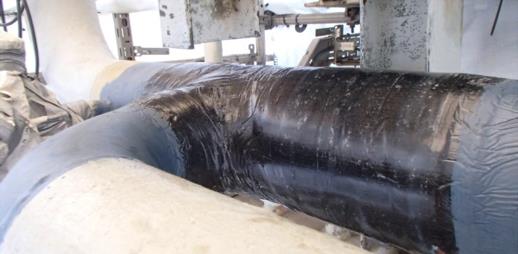International
Versatile Belzona composite SuperWrap II tackles complex geometries

In this situation, the customer highlighted how the 6” gas pipe system was suffering from corrosion between the pipe and support. Significantly, the hazardous part of the project was lifting the pipes because of internal pressures; therefore, in order to eliminate the associated risks, the project needed to be executed offline. In order to limit the downtime of the FPSO, the asset owner assigned a limited shutdown period, totalling 7 days.
Because welding was not an option, the application required a unique cold applied solution due to the total number of irregular pipe geometries, incorporating a well-engineered design, for both Tee junctions and sharp bends. Consequently, the customer selected Belzona SuperWrap II, because of the composite wrap’s versatility and ability to conform to complex geometries. Having previously worked with the Belzona Distributorship in Norway, CAN AS, the customer received a precise timeline for the applications, overall guaranteeing an efficient and structured process. Within this time, five of the days were specified for the design and installation of all six repairs, whilst the remainder allowed for curing and demobilisation of all equipment and personnel.
The application was carried out in accordance with ISO/TS 24817 and ASME PCC-2 Article 4.1., certifying the composite wrap system in line with equipment and piping repair regulations, for petroleum, petrochemical and natural gas industries. Prior to the installation, heavy equipment was rigged into place, necessary for lifting the large sections of pipe, consistent with engineering designs. Notably, some areas needed the use of rope access techniques, requiring an overall team of five operators, including riggers, inspectors and product specialists.
In order to determine the extent of the defect, ultrasound equipment was used to inspect the status of the damaged pipework. Eventually this revealed areas where more than a third of the substrate had succumbed to thin wall corrosion, thus demanding reconstruction of the pipeline surface before the application of Belzona SuperWrap II. As a part of the designated plan, the installation team assembled tarpaulin housing around the specific pipe defect, for grit blasting and climate control purposes. Each wrap application followed the same procedures, by initially grit blasting in accordance with Standard SA2.5, removing any foreign corrosive matter. Ultimately this provided an optimum substrate surface profile of 75µm, ideal for successful application. Once achieved, corrosion resistant Belzona 1111 (Super Metal) was used to rebuild the metal substrate. The versatile adhesive properties of the resurfacing epoxy-based composite, particularly on carbon steel substrates, created a level surface for the next stage of repair.
As highlighted, the complex pipe geometries included bends, straights and tees, necessitating a tailored design for the Belzona SuperWrap II application. The two-part, fluid grade resin system works in conjunction with a bespoke hybrid reinforcement sheet based on fibre glass and carbon fibre. The fibre glass offers flexibility, in addition to serving as a wet-out indicator, which ensures effective application of the reinforcement sheet. Interwoven with carbon fibres, the reinforcement sheet provides the composite wrap with the strength it needs to retain high pressures and loads. Belzona were able to cut the reinforcement sheets to match the unique pipe dimensions in the form of a reinforcement jackets for the tees, whilst utilising specifically measured strips for the bends. Before each application, the substrate was wetted with the fluid grade resin system, maximising the bond between the carbon steel and Belzona SuperWrap II. Covering lengths of 690mm, applicators used seven spirals of reinforcement around each defect, creating a tapered profile of 14mm at the densest section. Finally, this was consolidated by tightly wrapping release film around the composite wrap, which was later removed after the cure process was complete, allowing the repair to securely adhere.
-

 Alamaliktistaad Magazines2 months ago
Alamaliktistaad Magazines2 months agoAlam Al Iktisaad – September 2025 Edition
-

 News2 months ago
News2 months agoKitchenomiKs Secures Investment of US$3.2M Led by Jasoor Ventures
-

 Banking & Finance2 months ago
Banking & Finance2 months agoOman Arab Bank Highlights Its Ongoing Strategic Initiatives and Future Plans
-

 News2 months ago
News2 months agoIEA Expects Global Oil Market to Remain Oversupplied in 2026
-

 Energy2 months ago
Energy2 months agoWLGA Middle East LPG Summit & Expo 2025 to be held at OCEC on November 10 and 11
-

 Real Estate2 months ago
Real Estate2 months agoAl Mouj Muscat Unveils Azura Beach Residences Phase 2: A New Chapter in Waterfront Living
-

 Leaders Speak1 month ago
Leaders Speak1 month agoDhofar International Development and Investment Company: Driving Sustainable Growth and Strategic Synergies in Oman’s Investment Landscape
-

 Events1 month ago
Events1 month agoOER Corporate Excellence Awards 2025 Honours Entities and Innovations in Oman































You must be logged in to post a comment Login